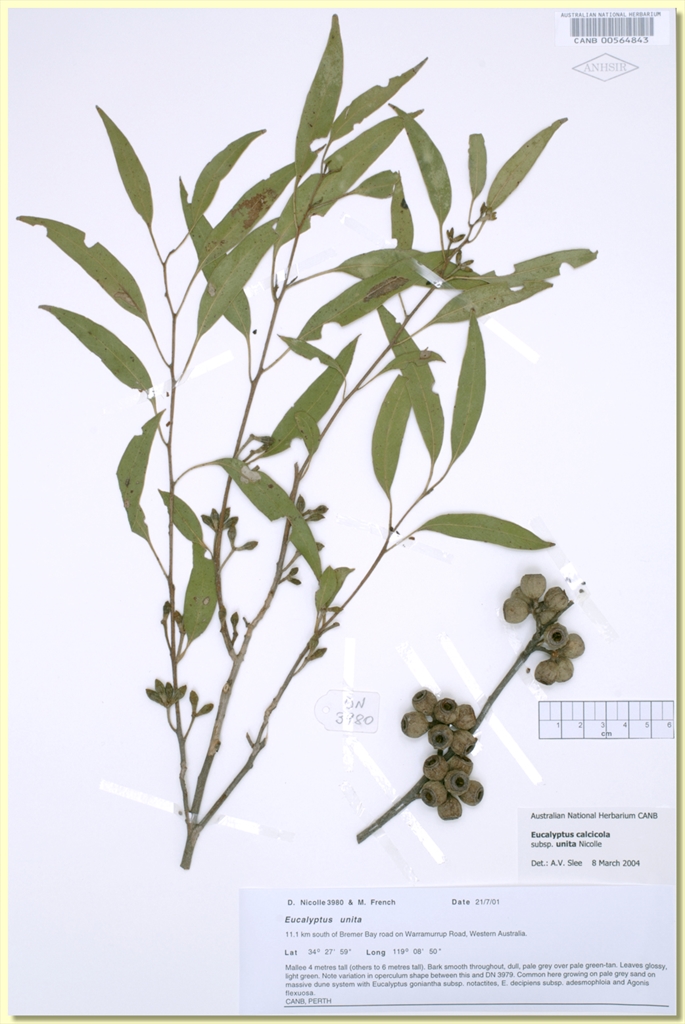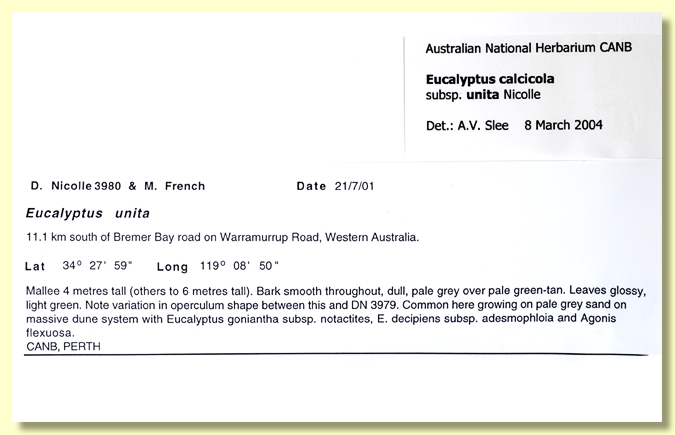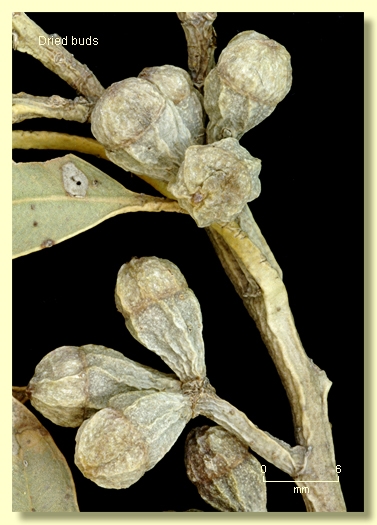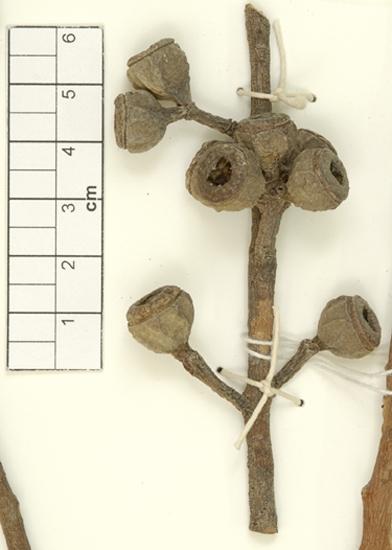Eucalyptus | Eucalyptus | Longistylus | Frutices | Calcicolae
Euclid - Online edition
Eucalyptus calcicola subsp. unita
Mallee or low shrub, 0.5 to ca 6 m tall. Forming a lignotuber.
Bark smooth, pale greenish grey, shedding in strips.
Branchlets lacking oil glands in the pith.
Juvenile growth (coppice or field seedlings to 50 cm): not seen.
Adult leaves alternate, petioles 1–2.5 cm long; blade lanceolate to falcate, 4.5–9(11.5) cm long, 1.2–2.2 cm wide, base tapering, margin entire, apex pointed, concolorous, slightly glossy, mid-green, side-veins greater than 45° to midrib, reticulation sparse to moderate, intramarginal vein remote from margin, oil glands irregular island or obscure.
Inflorescence axillary unbranched, peduncles flattened, 0.8–1.9 cm long, buds 7, 9 or 13 but rarely to 19 per umbel, pedicels 0.2–0.5 cm long. Mature buds obovoid to ovoid (0.7–0.9 cm long, 0.5–0.7 cm wide) with 8 to 10 shallow longitudinal ribs, scar absent, the single operculum rounded or conical, some outer stamens erect, inner stamens inflexed, anthers ± cuboid, versatile, dorsifixed, dehiscing by longitudinal slits that are not confluent apically, style long and straight (rarely bent in upper third), stigma more or less blunt, locules (3)4, the placentae each with 2 vertical rows of ovules. Flowers white.
Fruit usually pedicellate, rarely sessile (pedicels 0–0.4 cm long), cupular to hemispherical or tending to barrel-shaped, 0.8–1 cm long, 0.9–1.3 cm wide, shallowly ribbed, disc level to obliquely descending, valves (3)4, enclosed.
Seeds blackish, 2.5–4 mm long, obliquely pyramidal, dorsal surface curved, minutely wrinkled, ventrally ridged, hilum terminal.
Cultivated seedlings (measured at ca node 10): not grown; from protologue: cotyledons reniform; stems rounded in cross-section, sparsely hairy; leaves opposite, sessile, ovate, discolorous, green, to 5 cm long, 3 cm wide.
Flowering has been recorded in January.
Eucalyptus calcicola is a low shrub or mallee species known principally from the massive limestone dunes between Cape Freycinet and Cape Hamelin in far south-western Western Australia, with further occurrences at West Cape Howe and sporadically further east towards Bremer Bay. E. calcicola has smooth bark, a green slightly glossy crown, ribbed buds in axillary umbels, ribbed fruit which characteristically remain in dense clusters inside the crown, and glossy light green juvenile leaves that are opposite and sessile on the stems.
It belongs in Eucalyptus subgenus Eucalyptus series Calcicolae, a small group characterised by smooth bark, prominently ribbed buds with a single operculum (hence no operculum scar), ± cuboid anthers that shed pollen by two separate slits, and ovules arranged in 2 rows on the placenta, seedling and juvenile leaves opposite and sessile for many nodes, fruit ribbed and seed pyramidal.
E. calcicola is taxonomically closest to E. ligulata of the Cape Le Grande – Cape Arid area and of the Stirling Range. E. ligulata has more fusiform, less prominently ribbed buds and bluish green juvenile leaves that are ± lanceolate with tapering bases and in the seedling phase only have stem-clasping leaves for a few nodes.
There are two subspecies:
E. calcicola subsp. calcicola
Has larger fruit (1.1–1.5(1.7) cm wide) with much more prominent ribbing on both buds and fruit. The operculum is consistently conical. Restricted to the coast between Cape Freycinet and Cape Hamelin, well-known in the Boranup area.
E. calcicola subsp. unita
Has smaller fruit (0.9–1.3 cm wide) with less prominent ribbing on buds and fruit. The operculum may be conical or rounded. Found on the Southern Ocean coast from Point Hillier and West Cape Howe eastwards to the high limestone dunes near Bremer Bay.
Eucalyptus calcicola subsp. unita: Latin unitus, join together, referring to this subspecies being a morphological and geographic link between E. ligulata and E. calcicola subsp calcicola.















